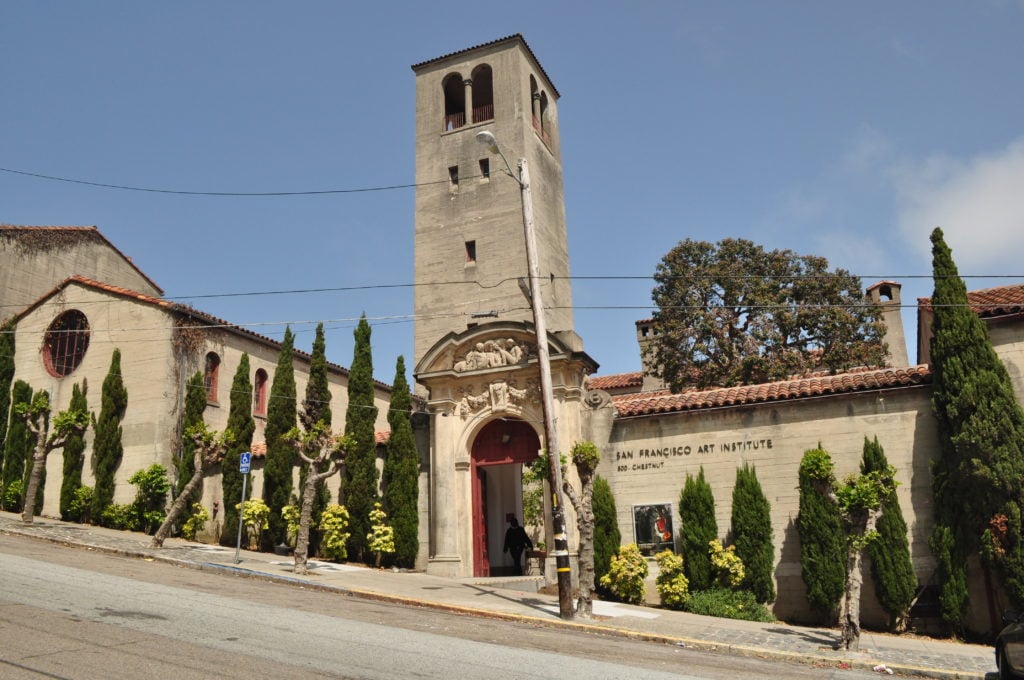Art World
With a Slimmed Down Educational Program, the San Francisco Art Institute Will Stay Open After All
The 149-year-old school will cancel its degree programs but offer public education courses in their place.

The 149-year-old school will cancel its degree programs but offer public education courses in their place.

Taylor Dafoe

Last month, the San Francisco Art Institute announced that it would shut down its degree programs and cease enrolling new students at the end of its current semester—a sign that, for many, signaled the end of the 149-year-old school.
But now, the future may not look quite so grim. This week, the institute’s board of trustees voted to keep the school open, in a limited capacity. The school will indeed suspend its degree programs after this spring, but rather than closing its doors for good, it will launch “a campaign to reset and reinvent the school’s business model,” according to an announcement.
In lieu of full-time programs, the school will offer studio art classes, public education programs, and grant-funded exhibitions and conservation projects while it continues to search for new solutions to keep the institution open long term.

The San Francisco Art Institute. Courtesy of Wikimedia Commons.
“Our doors are open and we will continue to fulfill SFAI’s mission while functioning in a leaner, more focused manner,” board chair Pam Rorke Levy said in a statement. “We’ll use the year ahead to pursue strategic partnerships with other schools and embark on an accelerated campaign to raise philanthropic funds. Our goal is to put SFAI on a firm financial footing, able to sustain itself moving forward.”
The board’s March letter prompted an “outpouring of support and encouragement from potential partners and charitable organizations,” the announcement this week explained, noting the numerous protests from students, faculty, and alumni that were incited as well. The full swath of reaction “convinced the board to take extreme measures to keep SFAI open.”
For others, though, the outlook isn’t so rosy.
“Like a lot of non-profit and donor driven institutions, the trustees at SFAI are trying to project an image of coherence and vision and deliberate intention so that maybe funding actually materializes,” says an anonymous adjunct faculty member at the school. “From the inside it starts to feel like gaslighting because the reality of the situation is pretty dire and obviously the press release doesn’t mention how terribly all of this works out for students.”
Indeed, before the backdrop of the institution’s precarious financial standing and the added pressures of the pandemic, a tension between the school’s leaders and its students and teachers has been festering.
“We want to make sure all are aware that while the board of SFAI is not calling this a closure, the effects to the community are identical to that of a closure,” read a letter put together by students and faculty submitted to the school’s administration last week. “We are suddenly left without a school, without jobs, and without a clear way forward during a global pandemic. For students and teachers, the results are devastating.”
Last week, two members of SFAI’s graduate studio committee also launched a petition calling on the school to compensate students in studio time and reimbursed tuition money for the loss of educational opportunities incurred by shelter-in-place policies. So far, 127 people have signed the document.
Levy and the school’s president, Gordon Knox, previously noted that they considered merging with another educational institution that had the resources to keep the San Francisco Art Institute afloat, but that talks with potential partners fizzled with the onset of the current public health situation. This week, Levy said they’ll look to rekindle those talks in the fall.
Additionally, the school will lease out its newly built graduate campus on the bay as a fundraising measure, and will partner with Sotheby’s for a pair of benefit auctions in 2020 (one in June and another in November).
The cutting of degree programs will still result in the laying off of tenured and adjunct faculty members, as well as long-time staff, who were notified of the changes in March.